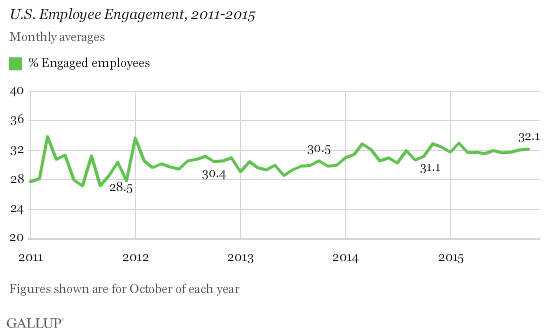Gallup released its monthly employee engagement statistics, and the survey revealed that monthly employee engagement readings have been nearly unchanged since March of this year. With 32.1% of employees identified as “engaged” (based on their ratings of key workplace elements), October 2015 employee engagement is slightly higher than its 2012 average of around 30%. This should be a point of concern for many employers since a 2015 Deloitte survey (Global Human Capital Trends 2015) found that “culture and engagement” was viewed as the most important challenge facing companies.

The good news is that employee engagement is experiencing the longest period of stability since Gallup first began its daily survey of U.S. workplace engagement in January 2011 and is on track to make 2015 a record year. The bad news is that employee engagement is still very low and costing employers billions of dollars, according to multiple estimates.
Employee engagement is a very broad concept and encapsulates a number of topics, and there isn’t a single solution that will solve all of the challenges employers are facing with tepid employee engagement. One thing is certain is that employees are more likely to engage at work when they know that their employers care about their wellbeing and think about them as more than just employees. We also know that employees that feel a stronger sense of community at work are more likely to thrive at their jobs. Certain wellness programs can help address employee engagement by improving employee health, showing employees that their company cares about them, and building community and culture. Wellness alone cannot solve the employee engagement problem, but it is certainly a critical tool for companies looking to tackle this internal challenge.













